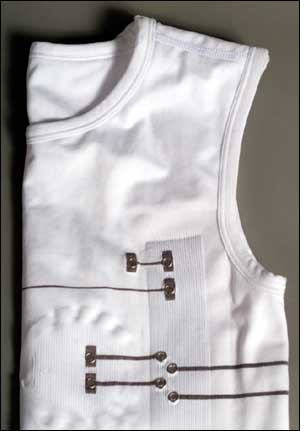Oct 01, 2009Remote patient monitoring is seen by many health-care experts as a way to reduce the cost of caring for aging populations in developed countries. Medical personnel at monitoring stations can track patients' vital signs and intervene before a problem becomes so severe that it requires an expensive hospital stay. Until recently, these systems required patients to wear sticky patches hooked up to peripheral devices and to transmit the data manually to a host system. Even when patients complied, vital signs were monitored only at specific times. Now, wireless technology promises to make remote monitoring easier to use and provide a continuous view of a patient's health status.
VivoMetrics, for example, is completing development of its next-generation LifeShirt system, which features a lightweight "smart garment," designed to be worn under a patient's clothing. It's embedded with three metallic electrocardiogram electrodes to monitor heart rate, as well as sensors to monitor breathing, posture, activity and temperature. The electrodes and sensors are connected with metallic yarn to an electronics box, about the size of a BlackBerry, that snaps into a pocket on the front of the garment.
The electronics box transmits the patient data automatically via cellular technology to medical personnel at a remote monitoring station. The information is fed into software that provides a scorecard of a patient's physiologic patterns. If a patient displays unusual or abnormal patterns, medical personnel can intervene by, for example, calling to remind the patient to take his or her medication or sending an ambulance.
The LifeShirt also works with peripheral medical devices that may be needed to monitor conditions such as blood pressure or blood oxygen saturation. Data from these devices is communicated via Bluetooth or ZigBee technology to the electronics box and then on to the monitoring station.
"The load that is on the health-care system is only going to increase as baby boomers age and develop health issues," says Alex Derchak, VivoMetrics' principal scientist. "We believe the way to effectively deliver health care in a cost-effective manner is to monitor those who are at risk in real time, so caregivers can be proactive and head off events that might lead to unnecessary hospitalizations."
VivoMetrics is conducting clinical trials of the LifeShirt and expects to launch the product early next year. The garment, which can be washed about 20 to 30 times before the metallic threads begin to deteriorate, will cost about $70, and the electronics box, which can be reused, will cost less than $1,000. The company believes third-party payers and managed-care organizations will pay for the system, because remote patient monitoring promises to reduce overall health-care costs.

